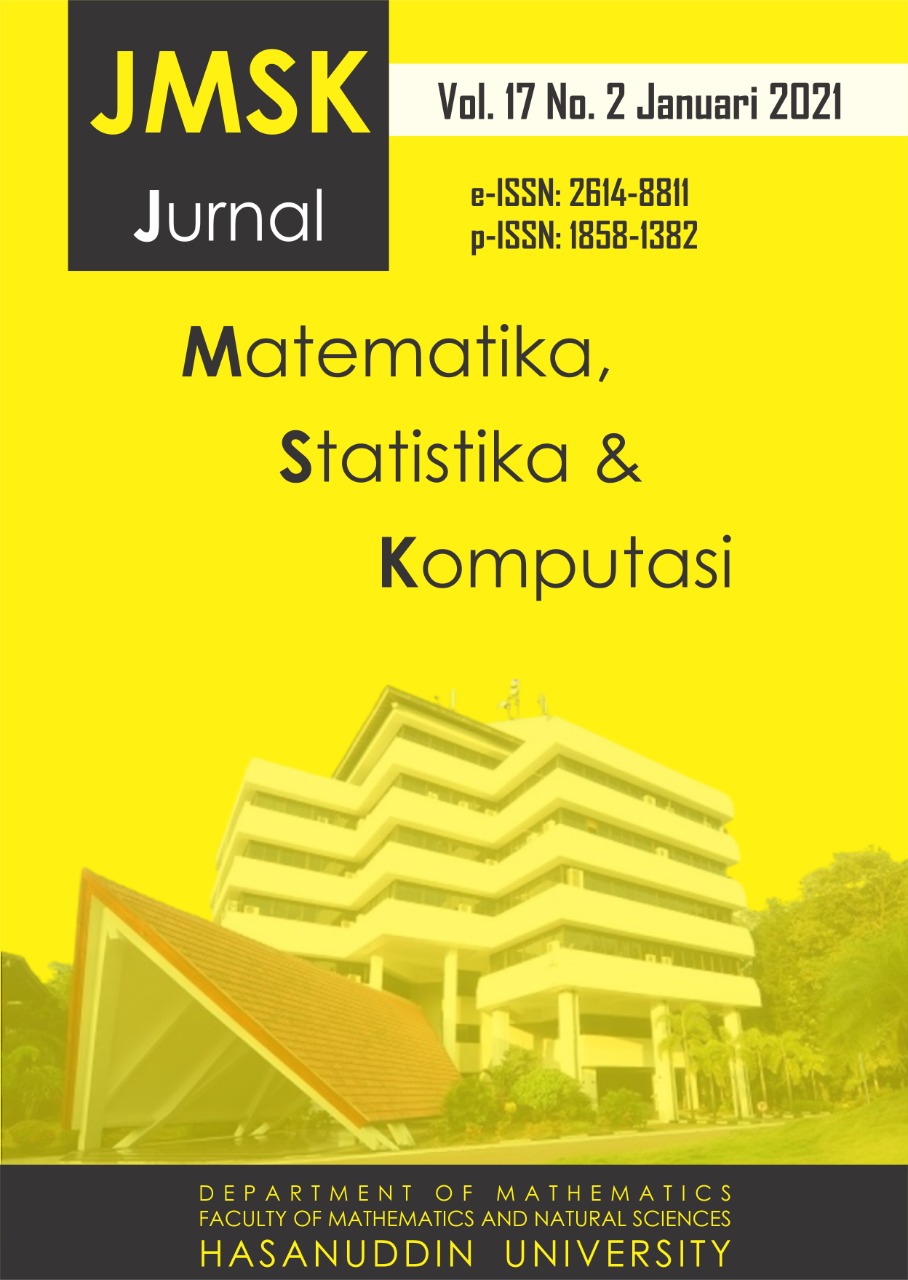SEIPR-Mathematical Model of the Pneumonia Spreading in Toddlers with Immunization and Treatment Effects
DOI:
https://doi.org/10.20956/jmsk.v17i2.11166Keywords:
Pneumonia, SEIPR Mathematical Model, Equilibrium Point, Basic Reproduction NumberAbstract
This research discussed the SEIPR mathematical model on the spread of pneumonia among children under five years old. The development of the model was done by considering factors of immunization and treatment factors, in an effort to reduce the rate of spread of pneumonia. In this research, mathematical model construction, stability analysis, and numerical simulation were carried out to see the dynamics of pneumonia cases in the population. The model analysis produces two equilibrium points, which are the equilibrium point without the disease, the endemic equilibrium point, and the basic reproduction number ( ) as the threshold value for disease spread. The point of equilibrium without disease reaches a stable state at the moment , which indicates that pneumonia will disappear from the population, while the endemic equilibrium point reaches a stable state at that time , which indicates that the disease will spread in the population. Furthermore, numerical simulations show that increasing the rate parameters of infected individuals undergoing treatment ( ), the treatment success rate ( ), and the immunization proportion ( ), could suppress the basic reproductive number so that control of the disease spread rate can be accelerated.
References
. Ndii, M. Z. P. (2018). Pemodelan Matematika. CV Budi Utama, Yogyakarta.
. WHO. Pneumonia. (2016). URL http://www.who.int/news-room/factsheets/detail/pneumonia [17 Desember 2019]
. Kemenkes RI. (2017). Data dan Informasi ProfilKesehatan Indonesia 2017. Kementerian Kesehatan Republik Indonesia, Jakarta.
. Riskesdas. Badan Penelitian dan Pengembangan Kesehatan Kementerian RI. (2018). URL http://www.depkes.go.id/resources/download/info-terkini/hasil-riskesdas-2018.pdf. [17 Desember 2019]
. Jacob, O., Joseph, M., & Paul, O. (2013). Mathematical Model for Pneumonia Dynamics with Carriers. Journal of Math, Vol. 7, No. 50, 2457–2473.
. Rahmawati, H., Widowati, & Kartono. (2015). Analisa Kestabilan Model Matematika Penyakit Pneumonia Dengan Carriers. Jurnal Matematika, 4(2).
. Fajar, R., Sari, M., Kurniastuti, I., & I., L. (2016). Analisis Kestabilan Model Matematika Penyebaran Infeksi Penyakit SARS dengan Faktor Host dan Vaksinasi. Seminar Nasional Matematika dan Pendidikan Matematika UNY.
. Dinkes Surabaya. Infeksi Saluran Pernafasan Akut dan Pneumonia Pada Anak, (2013). URL http://dinkes.surabaya.go.id. [17 Desember 2019]
. Setiati, S., Alwi, I., Sudoyo, A., Simadibrata, M., Setiyohadi, B., & Syam, A. (2015). Buku Ajar Ilmu Penyakit Dalam. InternaPublishing, Jakarta Pusat.
. Kaneshiro, N. K. & Zieve, D. Pneumonia – Children – Community Acquired, 2016. URL https://medlineplus.gov/ency/article/007690.htm. [17 Desember 2019]
. Driessche, P. & Watmough, J. 2002. Reproduction Number and Subtreshold Endemic Equilibrium for Compartmental off Disease Transmission. Mathematical Biosciences, 180:29–48.
. Resmawan, R., & Nurwan, N. (2017). Konstruksi Bilangan Reproduksi Dasar pada Model Epidemik SEIRS-SEI Penyebaran Malaria dengan Vaksinasi dan Pengobatan. Jurnal Matematika Integratif, 13(2), 105. https://doi.org/10.24198/jmi.v13.n2.12332.105-114.
. Susanti, N. D. (2016). Analisis Perhitungan Bilangan Reproduksi Dasar (R0) pada Model Matematika Dinamika Malaria Host-Vector. Skripsi, Universitas Islam Negeri Maulana Malik Ibrahim Malang.
. Ault, J.C & Ayres, Frank. (1999). Persamaan Diferensial dalam satuan SI Metric. Erlangga, Jakarta.
. Tu, P. (1994). Dyamical System: An Introduction with Applications in Economics and Biology. Springer-Verlag, New York.
. Fajariyah, N. I., Sukestiyarno, Y. L., & Junaedi, I. (2018). Pemodelan Matematika Penyebaran Penyakit Tuberkulosis Dengan Strategi DOTS. UNNES Journal of Mathematics, Vol. 7, No. 2, 136-137.
Downloads
Published
How to Cite
Issue
Section
License
Copyright (c) 2020 Author and publisher

This work is licensed under a Creative Commons Attribution 4.0 International License.

This work is licensed under a Creative Commons Attribution 4.0 International License.
Jurnal Matematika, Statistika dan Komputasi is an Open Access journal, all articles are distributed under the terms of the Creative Commons Attribution License, allowing third parties to copy and redistribute the material in any medium or format, transform, and build upon the material, provided the original work is properly cited and states its license. This license allows authors and readers to use all articles, data sets, graphics and appendices in data mining applications, search engines, web sites, blogs and other platforms by providing appropriate reference.







